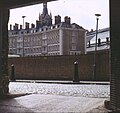History
Origins of the company
Britain's private railway companies pioneered the concept of the railway hotel, initially at locations such as London Euston and Birmingham Curzon Street where hotels were opened at the start of trunk railway operation in 1839. Most of the railway companies followed suit, and by 1913 there were 93 railway owned hotels. After grouping, the policies of the 'big four' railway companies differed considerably: the LMS and LNER, which had the longest routes, were the most enthusiastic.
| Company | Hotels | Bedrooms | Guests |
|---|---|---|---|
| LMS | 26 | 2,429 | 748,765 |
| LNER | 17 | 2,328 | 449,355 |
| GWR | 4 | 336 | 136,307 |
| SR | 2 | 224 | 75,000 |
The Hotels Executive (1948–53)

At the nationalisation of transport in Great Britain on 1 January 1948, and the establishment of the British Transport Commission, hotels and catering came under the control of BTC's Railway Executive. However, on 1 July 1948 they were separated from direct railway control and placed under British Transport Commission's Hotels Executive, chaired by Lord Inman, who was later succeeded by Sir Harry Methven. At this point the Hotels Executive acquired 55 hotels and 400 station refreshment rooms, along with various golf courses, tennis courts, laundries, wine cellars, bottling stores and even a farm (at St Ives in Cornwall).
British Transport Hotel and Catering Services (1953–63)
The Conservative government elected in 1951 sought to alter the structure of the British Transport Commission and its subsidiaries. One consequence was that the Hotels Executive was abolished on 19 August 1953, and the BTC took direct control, establishing a "Hotel and Catering Services Division" to run them. Sir Harry Methven, the last Chairman of the Hotels Executive, became a member of the BTC.
British Transport Hotels Ltd (1963–83)
In 1962 the BTC was abolished, and its rail businesses were transferred to the newly established British Railways Board. The BRB Chairman, Richard Beeching, argued for the retention of the hotels within the BRB's rail portfolio, and BTH Ltd was established to manage them. The intention was to give BTH a high degree of autonomy, including bringing in outside expertise in the hotel business to the BTH board. The Railways Act 1968 empowered BTH to expand beyond the railway estate, and the company considered opening a number of new hotels. In the event only one such hotel was opened – the Old Course at St Andrews – in 1968, before the Conservative government elected in 1970 stopped further expansion. The remainder of the hotel estate was rationalised: the 34 hotels inherited by BTH had been reduced to 29 by 1979.
The end (1983–84)
This section needs additional citations for verification .(December 2024) |
Following the victory of the Conservative Party at the 1979 general election, led by Prime Minister Margaret Thatcher, and the deteriorating economic situation, pressure was put on nationalised industries such as British Rail to consider asset disposal. It was not long before the BTH hotels were under review. The management at the time, led by Peter Land, tried to establish a viable structure for a management buyout, which would have kept the group more or less intact and would have delivered a smooth transfer to the private sector. As Peter Land notes in his book Sauce Supreme, politics rendered this plan impossible and the hotels were sold by open tender, realising a much lower value for the UK taxpayer than the management buyout would have done. [1] By 1984, the disposal was complete and the history of BTH was at an end.

















